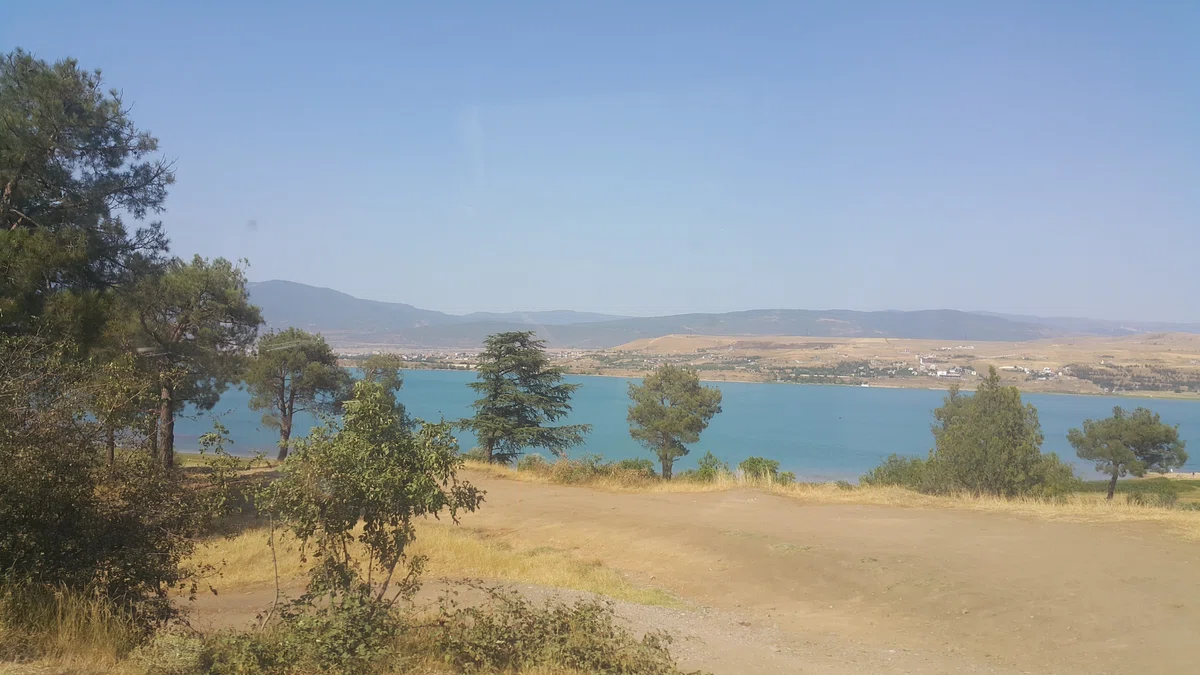
What resorts on the waters are worth visiting in Georgia? Tbilisi Reservoir resort.
A popular resort place, the Tbilisi Reservoir or the sea, was created on the site of several small salt lakes. In summer, the water temperature rises to 28 degrees, which attracts tourists very much. The Tbilisi National Park was founded around the reservoir, which is the most important center of tourism development.
Tbilisi Reservoir (Tbilisi Sea) it extends for 11.8 km to the east of the city. It was created in 1951 on the site of several small salt lakes - Avlabar, Ilgunian and Kukian. It is assumed that all three of these lakes in ancient times were in the bed of the Kura River. The length of the reservoir is 8.75 km, the maximum width is 1.85 km, the total area is 11.6 km2, and the maximum depth is 45 meters. The reservoir is replenished mainly by the waters of the Iori and Aragvi rivers. It is used for irrigation needs, for water supply of Tbilisi, for fishing, for water sports.

TBILISI RESERVOIR
The water temperature of the Tbilisi Sea is characterized by very high variability (on average 18 °). The water in the reservoir does not freeze, although the coastal strip (that is, the shoal) is covered with ice. In July and August, the water warms up to +26 °, and then the Tbilisi Sea becomes an attractive place for many vacationers.
In 2007, at the expense of the forest lands of the Tianeti, Mtskheta and Sagaredzh forestry, Didgorsky experimental and demonstration forestry and Saguramsky State Nature Reserve was restored and expanded Tbilisi National Park, which was founded in 1975. This park is called the lungs of the city. The purpose of this park is to preserve rare plants and the forest ecosystem characteristic of this territory in the central part of Eastern Georgia, to protect biological and landscape diversity, to create prerequisites for environmental safety, as well as to ensure the development of recreational, ecotouristic and educational activities in the natural environment.
The Tbilisi National Park is also important from the point of view of tourism development. The protected area is located near two significant cities of Georgia- Tbilisi and Mtskheta is directly adjacent to the architectural masterpiece of the sixth century - Mtskheta Jvari from here an extraordinary panorama of the city of Mtskheta opens.
Location: Ior plateau, northeast of Tbilisi.
Distance: from the center of Tbilisi - 12 km.
Altitude above sea level: 630-650 m.
Terrain: mountainous and hilly.
Climate: mild, continental, moderately dry. Winter is mild, with little snow, the average temperature in January is -1 °C. Summer is hot. The average temperature in August is 24°C.
Average annual precipitation: 554 mm.
Relative humidity: 66%.
Duration of sunshine per year: 2112 hours.

The Tbilisi Reservoir is not only a popular resort destination, but also an important piece of infrastructure. The reservoir is a source of drinking water for the city and also provides it with electricity. However, the main attraction remains, of course, its tourist potential. The reservoir is only 11 km away from the city center, and here you can spend the whole day enjoying swimming, fishing and other water activities. Also in the park you can taste Georgian cuisine in the cozy cafes and restaurants. On the territory of the park there are many attractions, among which is worth noting the old church of St. Michael, which was built in the 19th century. You can also see interesting museums and galleries, visit the tasting centers of local producers of wine and chacha. But the reservoir is not only a place for recreation and entertainment. Here you can also do sports and active recreation. The park has sports grounds where you can play soccer or volleyball, as well as bike paths and horseback riding trails. At the same time, beautiful scenery and fresh air will help you forget about all the problems and relax.
The area is an ideal place for ecotourism. In the national park you can see many species of animals and plants that are characteristic of the region. Among them, various species of wildlife stand out, including roe deer, wild boar, foxes and many others. You can also see rare species of birds, such as eagles, falcons and hawks. The sea is a great place for a variety of water sports. Swimming, water skiing, kitesurfing and other water activities can be done here. You can also visit many attractions in the area, including museums, temples, and castles.
Tourists who are planning to visit the sea, you should pay attention to the fact that there are some rules of conduct. First, it is forbidden to swim in unauthorized places, as it can be dangerous to life and health. In addition, it is worth remembering that it is a drinking water reservoir, so you should not throw garbage and pollute the environment.
Tbilisi National Park is located on the Jordan Plateau, in the northeastern part of the city. It is a mountainous and hilly area, located at an altitude of 630-650 meters above sea level. The climate is mild, continental, moderately dry. Winters are mild and snowy, the average temperature in January is about -1 ° C. Summers are hot, the average temperature in August reaches 24°C.
The average annual precipitation in Tbilisi National Park is 554 mm and the relative humidity is 66%. The duration of sunshine here is 2112 hours per year.
This climate makes the national park an attractive place to visit at any time of the year. Here you can enjoy the beauty of the mountains, ancient forests and rivers, spend time on a picnic in the shade of trees and enjoy the clean air. In addition, the national park is located in close proximity to two major cities of Georgia - Tbilisi and Mtskheta, which makes it accessible to tourists who want to explore the natural and cultural attractions of the region.
Thus, the Tbilisi Sea and Tbilisi National Park offer many opportunities for recreation and excursions. Readers who are planning to visit this region are encouraged to leave comments under the article and ask questions for more information about local attractions and rules of conduct.












33 comments
Log in to leave a comment
Тбилисский национальный парк был основан в 1975 году и называют его лёгкими города.
Оно было создано в 1951 году на месте нескольких небольших солёных озёр - Авлабарского, Илгунианского и Кукийского. Считается, что все три озера в древности находились в русле реки Куры.